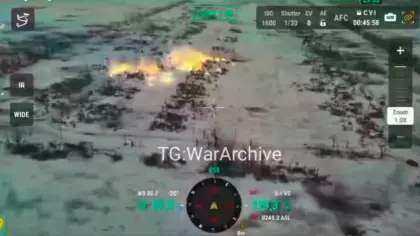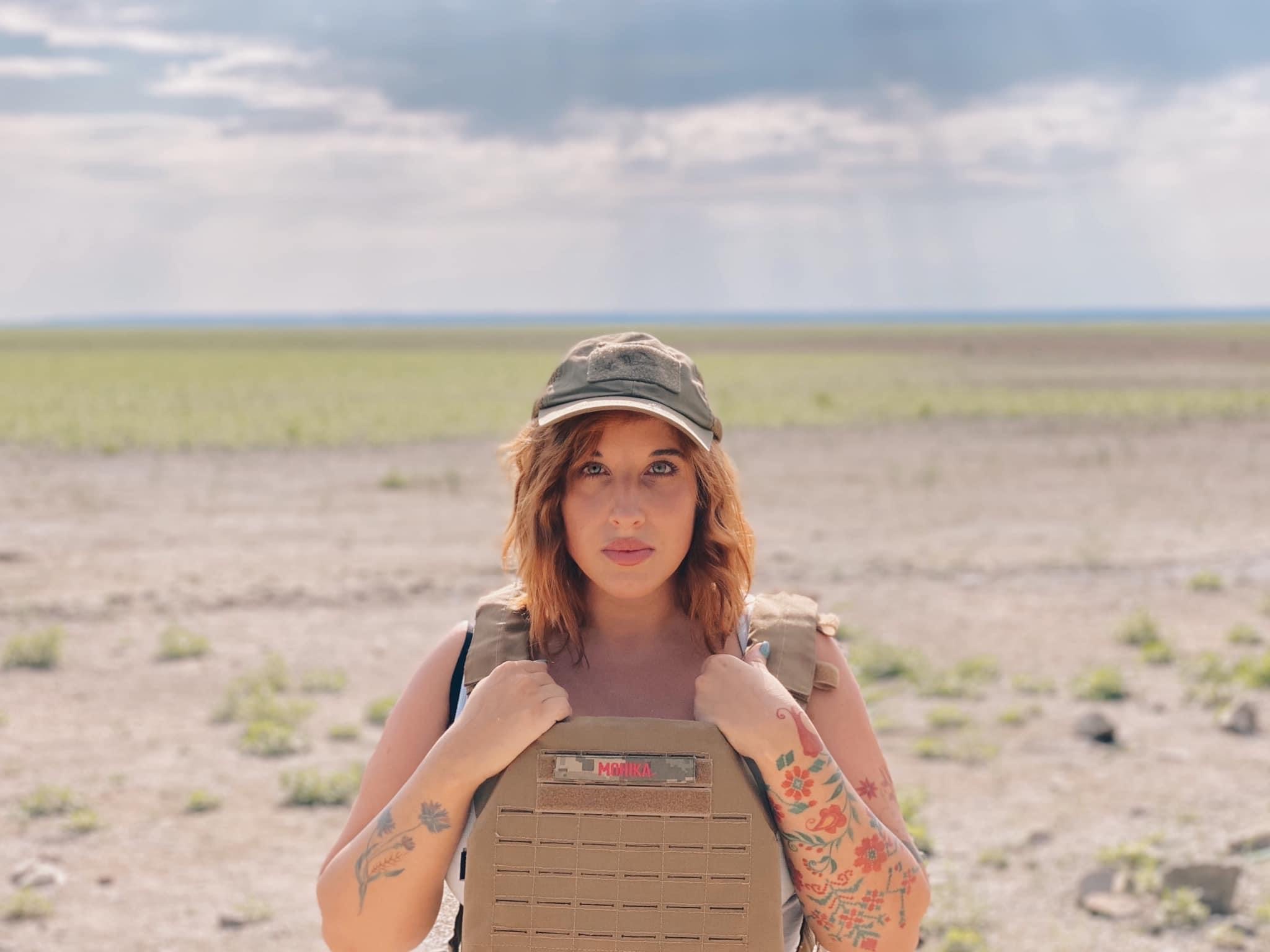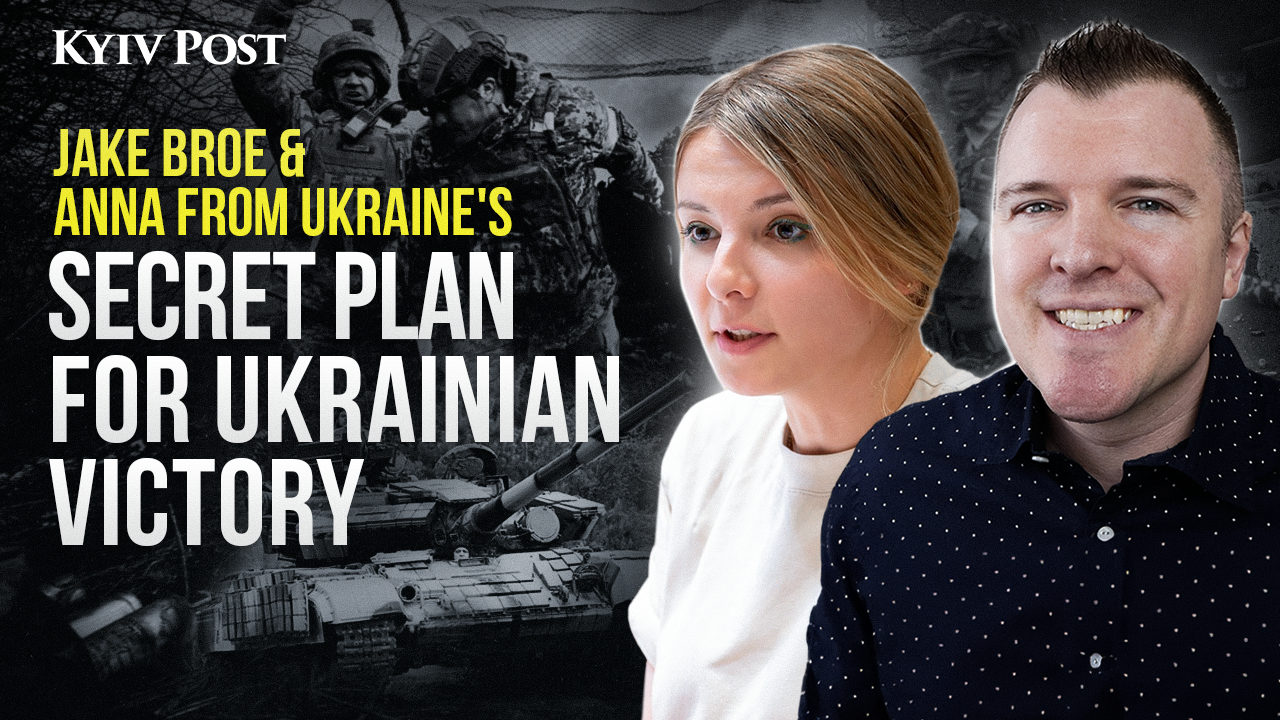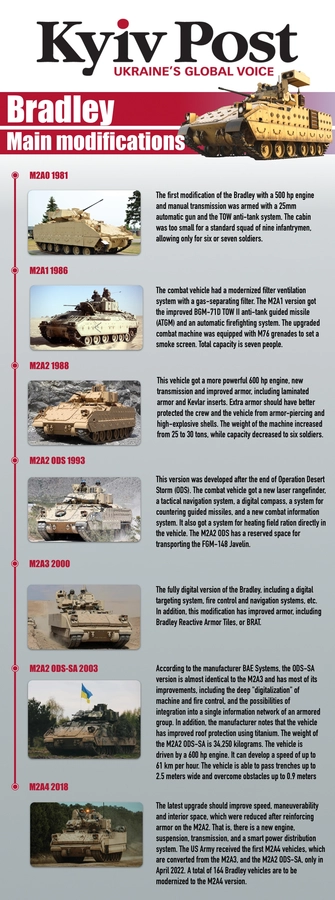Earlier this week, a video of one of Russia’s best and most modern tanks being absolutely hammered by a – on paper – far less powerful infantry fighting vehicle, lit up social media.
The viral drone video first published by Ukraine's 47th Mechanized Infantry Brigade, sees a US-made M2 Bradley hitting a Russian T-90 tank at point bank range, smashing the heavily-armored Russian vehicle with dozens of 25mm high explosive rounds.
JOIN US ON TELEGRAM
Follow our coverage of the war on the @Kyivpost_official.
There are three things you can watch forever. Like this Ukrainian M2 Bradley IFV obliterating a «no-analogue» russian T-90M tank.
— Defense of Ukraine (@DefenceU) January 18, 2024
📹: 47th Mechanized Brigade pic.twitter.com/4NwvEryE3Y
To be clear – the US-made M-2 Bradley infantry fighting vehicle is not a tank, and on paper the Russian T-90s should have been more than a match even for two Bradleys.
So how come they came out on top?
America's venerable Bradley infantry fighting vehicle is popular with Ukrainian troops fighting the Russian army for much the same reasons that US Army infantrymen came to value the vehicle in battlefields in Iraq and Afghanistan: powerful weapons, outstanding optics and excellent cross-country ability.
By some accounts, the most powerful infantry fighting vehicle not just in the war but in any army anywhere, is the Bradley.
History of the Bradley
The appearance of Bradley combat machines stemmed from the US Army’s experience during the Vietnam War. At that time, M113 armored personnel carriers were used as assault vehicles, but they were not sufficiently protected and armed for such tasks.
In 1978, the first prototypes of XM2 and XM3 infantry fighting vehicles were developed. In 1980, FMC Corporation obtained the first contract for production of 75 XM2s and 25 XM3s.

VIDEO: HIMARS Strike Targets Russian Troops Training Ground
The following year, the letter X (meaning "experimental") disappeared from the name when the vehicles were taken into service.
Despite the Bradley being developed in the 1970s, it is still considered one of the best and most successful in the world. Having been constantly improved and modified, it remains a reliable and effective combat machine used by the armies of more than 20 countries.
Bradley fighting vehicles in Ukraine
Ukraine received about 190 M2A2 ODS-SA Bradley infantry fighting vehicles from the US. This is one of the most modern versions of this machine.
The M2A2 ODS conventional modification was developed in 1995, drawing on combat experience in Iraq during Operation Desert Storm and with significant improvements to the specification.
The ODS version got a new eye safe ELRF laser rangefinder with a range of up to 10 kilometers.
The vehicle also employs the tactical TACNAV navigation system with a GPS receiver and a digital compass. This determines the exact location of the vehicle and allied troops on the ground.
To improve effectiveness in the dark, the M2A2 ODS is also equipped with a modern thermal imaging sight.
The M2A2 ODS and M2A2 ODS-SA modifications are very similar, but there are several key differences.
Ukraine received a more modernized version of the M2A2 ODS-SA, with more advanced electronics significantly improving its characteristics. For example, the gunner in the M2A2 ODS-SA modification has a second-generation panoramic sight with a thermal imager.
The Bradley's firepower
Both vehicle modifications are armed with the 25mm M242 Bushmaster chain gun, the twin 7.62mm M240C machine gun and the TOW anti-tank missile system.
During the Persian Gulf War, the Americans had a unique experience of interacting between Abrams tanks and Bradley infantry fighting vehicles, witnessing the high firepower of the latter. Using TOW anti-tank missiles, the Bradley combat machines destroyed more T-72 tanks than the Abrams did.
It is worth noting that the updated M2A2 ODS-SA, which appeared in 2003, is in no way inferior to the Bradley M2A3 version in terms of its characteristics. The only difference is the absence of the panoramic commander's sight.
The machine is equipped with the advanced FCSW fire control system similar to that installed on M1A2 Abrams tanks. This system takes into account data from laser rangefinders, speed of movement of the combat vehicle and the target, weather conditions and types of projectile. All this makes it possible to hit the target after its detection from the first shot without preliminary firing or stopping the combat vehicle itself.
The main armament of the combat machine remains the 25mm M242 Bushmaster chain gun with an ammunition load of 900 shots. Of these, 300 are in the cannon with an extra 600 in storage. The maximum range of effective fire is two to three kilometers, depending on the ammunition used.
To destroy heavily armored targets, the Bradley is armed with the TOW 2 anti-tank guided missile (ATGM). The launcher for two ATGMs is located on the left side of the turret. Five more guided missiles are transported inside the vehicle (seven missiles in total).
As the practice of using these vehicles in Ukraine shows, the 25mm M242 Bushmaster gun is sometimes enough to disable an enemy tank.
Thus, on Jan. 13, the 47th separate mechanized brigade reported the destruction of a state-of-the-art Russian T-90 Proryv (Breakthrough) tank in the Avdiivka direction thanks to the Bradley.
Constant fire from the 25mm gun disabled a number of vital systems of the T-90 Proryv – the Russian "flagship" of tank manufacturing.
The crew operating the T-90, the most modern and advanced tank committed by Russia to fighting in Ukraine, seems unable to respond to the pounding, despite the tank's in some places meter-thick armor, designed specifically to prevent damage from light autocannon like the Bradley's.
Bradley IFV of the 47th Brigade of Ukraine engages in a battle with Russian T-90M, Avdiivka front. (Bradley is in foreground while T-90M is in the middle of the village). At the end of the video it’s visible that tank most likely received significant damage as the crew cannot… pic.twitter.com/uutTexfXf5
— Special Kherson Cat 🐈🇺🇦 (@bayraktar_1love) January 12, 2024
However, while some of the 25mm cannon shells hit and explode visibly on the T-90's outer armor, others seem to penetrate partially before detonating.
The Russian tank takes multiple hits and pieces of equipment bolted to the exterior of the Russian tank's hull and turret are sent flying.
The Russian crew eventually retreats, with the tank turret seemingly spinning constantly because of a mechanical malfunction. The T-90 eventually stops after hitting a tree and the crew abandons the tank.
Some Russian mil-bloggers blamed the engagement's outcome on the T-90 crew's allegedly poor training and combat skills, claiming the T-90's powerful cannon should have taken out the Bradley in a single shot, and that if the tank's cannon or fire-control system had been damaged, the T-90 commander should have fired protective smoke grenades or returned fire with a machine gun on top of the turret.
But damage caused by the chain gun might have broken those systems, one said.
The Ukrainian crew
Such was the interest in the video of the Bradley taking out the T-90, Ukrainian media found the crew responsible to ask them how they did it.
Their secret – in part at least, video games.
Describing the moment they first saw the tank, commander and gunner Serhiy said: “My heart properly went off.
“In training I said to myself ‘god forbid I see a tank in my sights.’ But it so happens I did, and very close.”
Serhiy describes firing at the T-90 “with everything we had” but then says they had difficulty making headway against it.
He then says: “But as I used to play video games, I remembered everything – both how to hit them and where.”
A more personal and detailed interview with the crew of the Ukrainian Bradley which took on a russian T-90M. Also goes over using American-supplied Bradley IFVs in conditions of the Ukrainian winter 💪 pic.twitter.com/GtSGt8Cxiq
— WarTranslated (Dmitri) (@wartranslated) January 19, 2024
Safety features
Bradley combat vehicles are well protected against a range of other threats. Following the war in the Persian Gulf, the US Army began to install special dynamic protection Bradley Reactive Armor Tiles, or BRAT, on its fighting vehicles.
This system is very effective against cluster and some kinetic munitions. For the most part, this is designed to protect the vehicle and its crew from hand-held grenade launchers and anti-tank systems. BRAT defense kits were also transferred to Ukraine, with a system comprising of separate modules. Upon damage to a certain area of its dynamic protection, replacement with a new one is easy.
In terms of crew protection, the US-supplied Bradley cannot even be compared with the Soviet BMP-1 or BMP-2 armored vehicles. The Bradley is much safer, more reliable and more effective on the battlefield.
With Ukrainian fighters, arguably in battle with a far more powerful and better-armed opponent than any Bradley-equipped American force has ever faced, one feature stands out above all others – the vehicle's impressive ability to take a massive hit that would demolish most other armored transporters, and keep the soldiers inside alive.
To improve protection of the crew and troops from debris, the internal surfaces of the hull and turret of the M2A2 ODS-SA are lined with Kevlar padding. Thanks to this reinforcement of armor, the machine has become almost invulnerable in the forward projection to fire from the 30mm Soviet automatic cannon mounted on the BMP-2 combat vehicle.
This improved armoring increased the total weight of the machine and required a new, more powerful 600 hp engine. This allows the 34.2-tonne machine to reach a maximum speed of 61 kilometers per hour.
You can also highlight the text and press Ctrl + Enter











